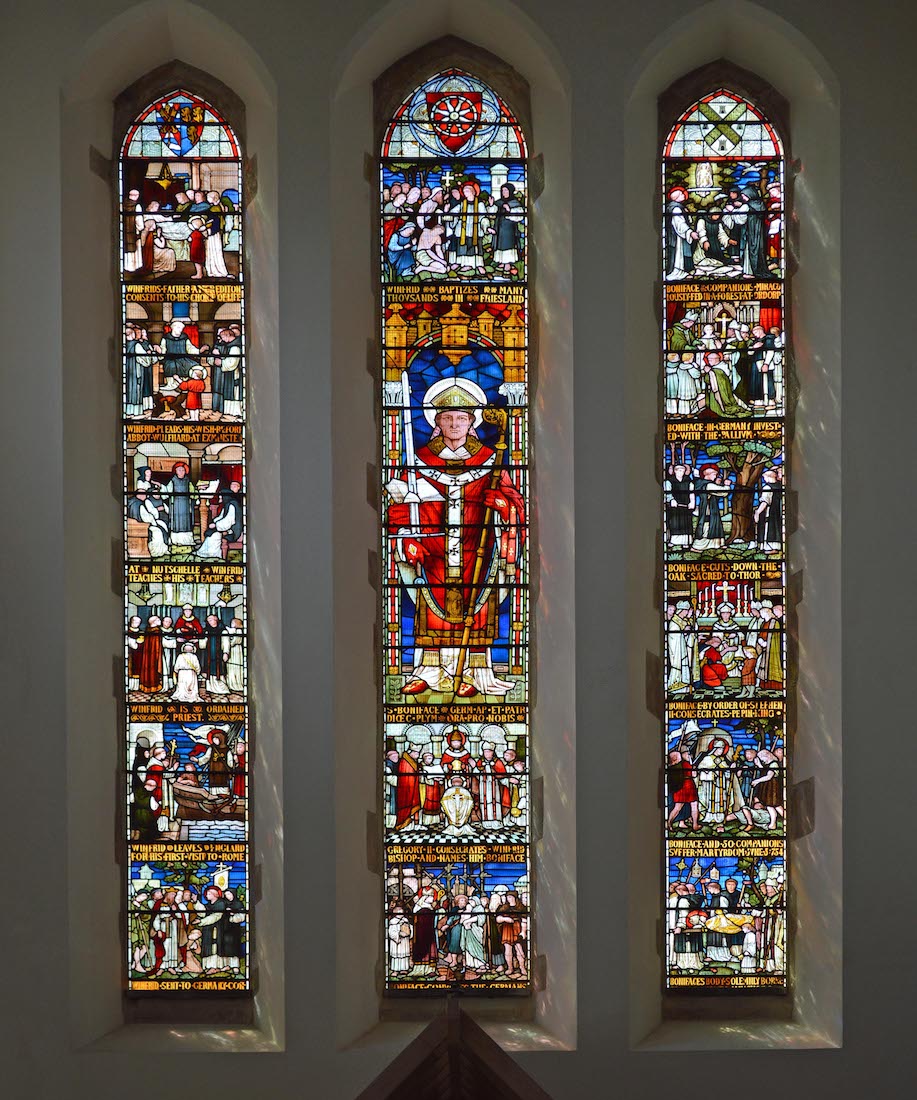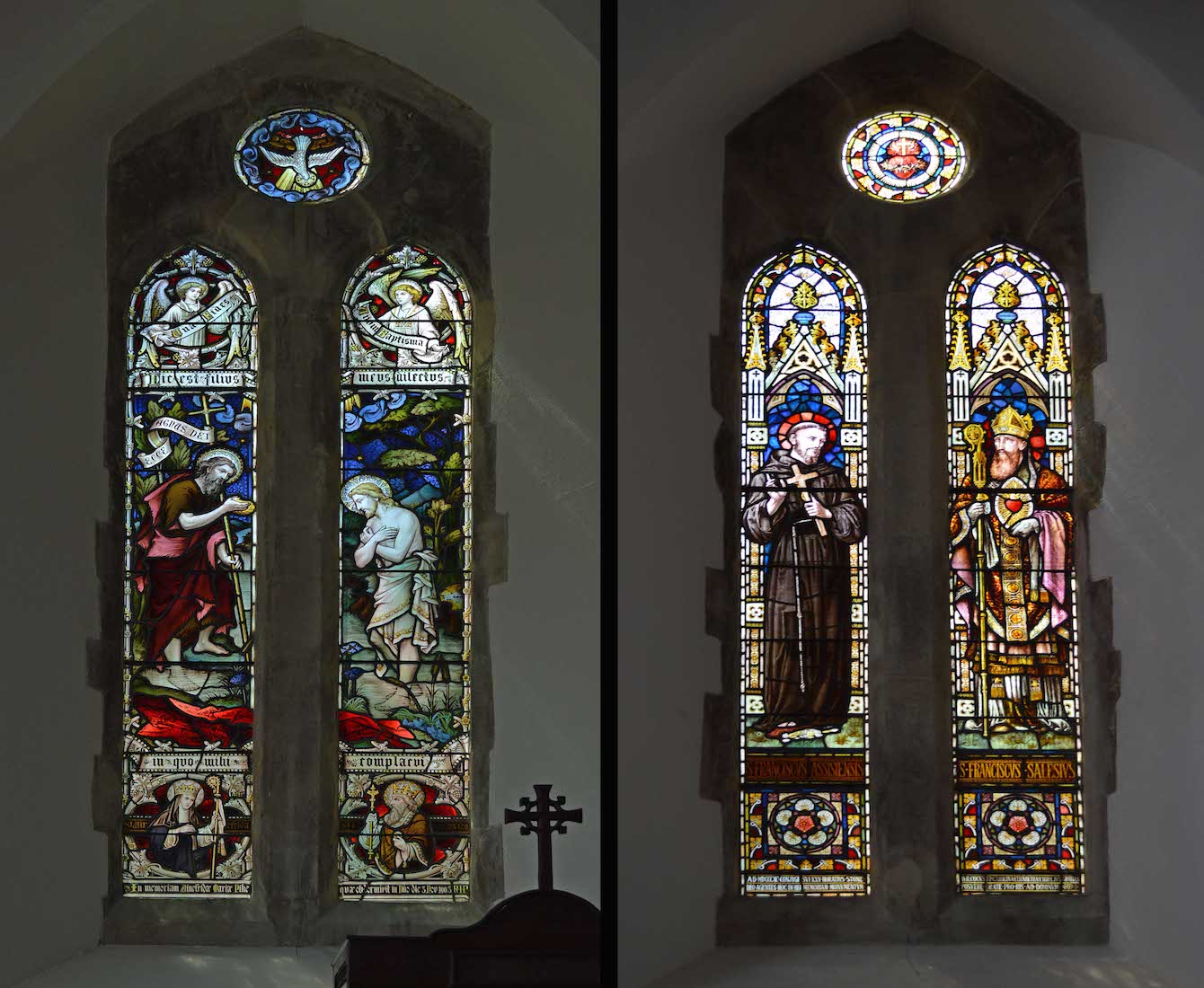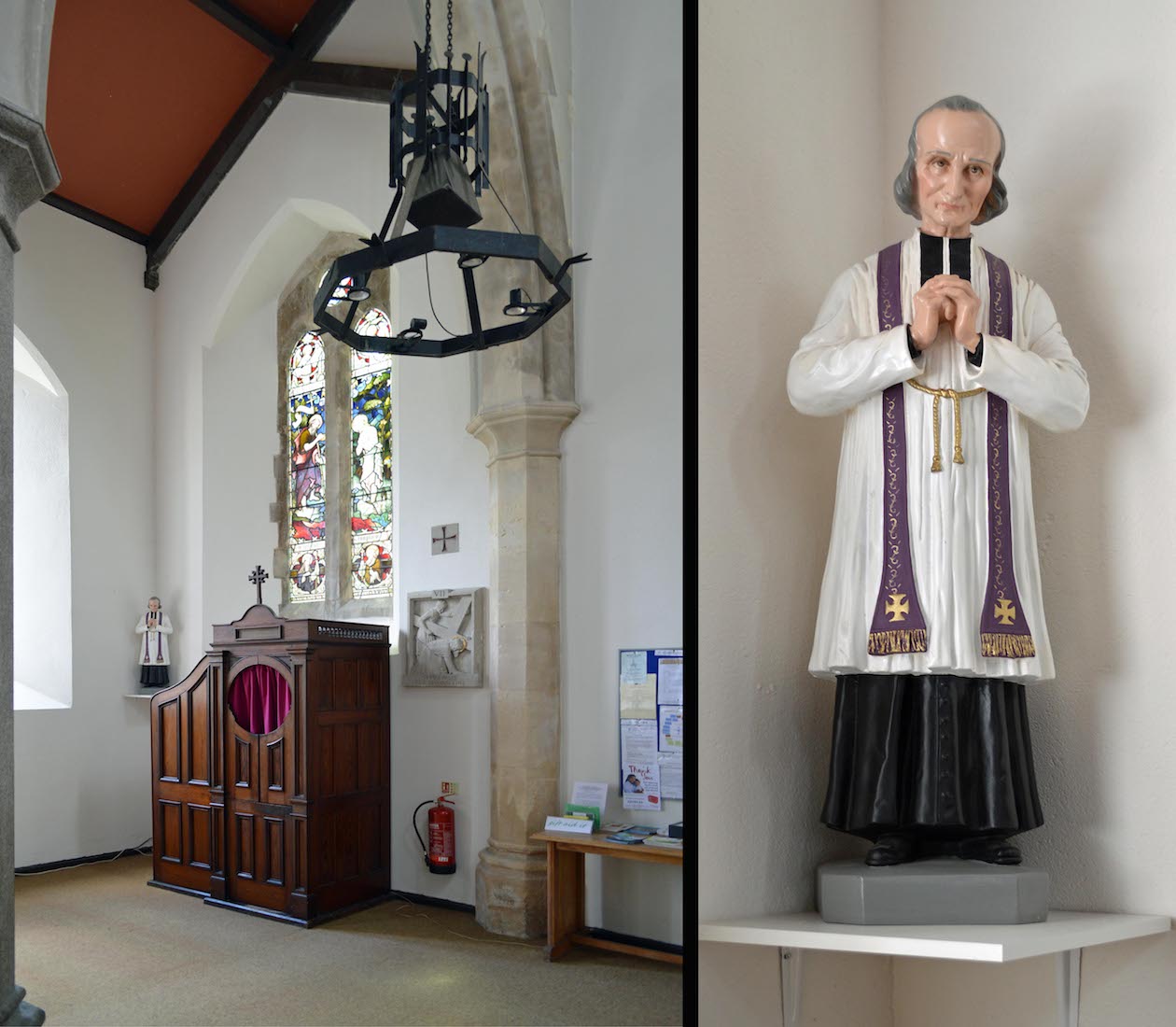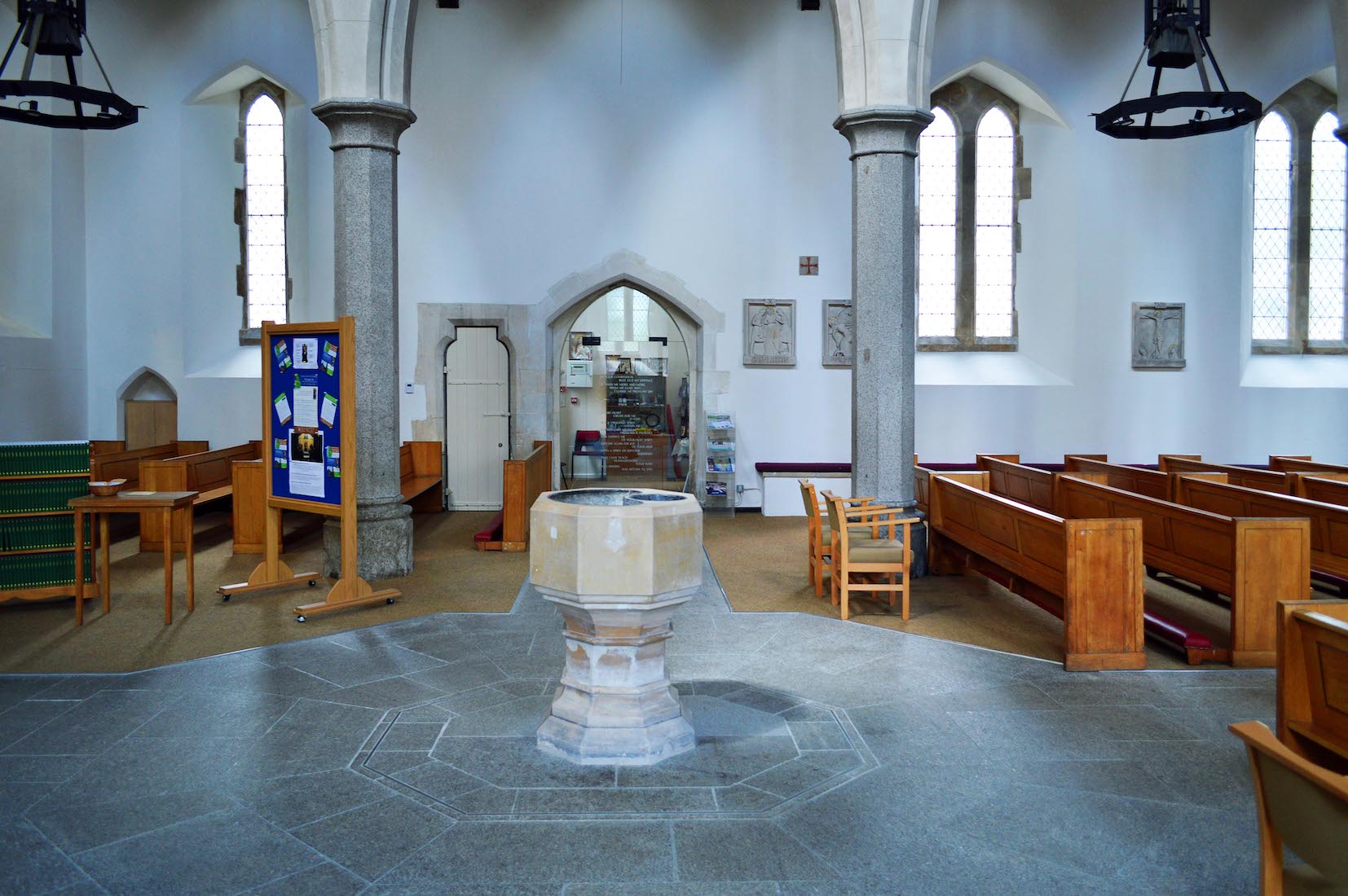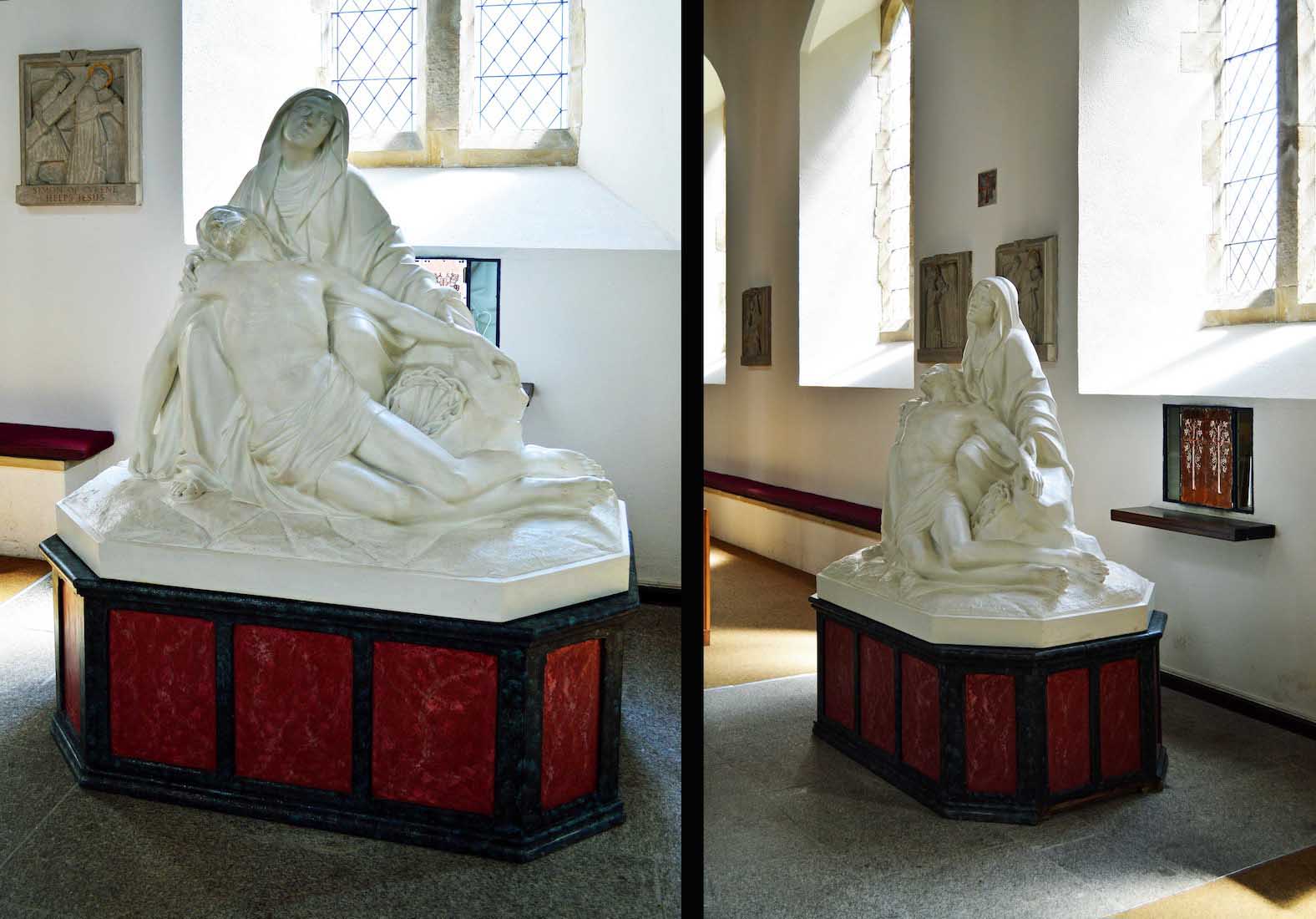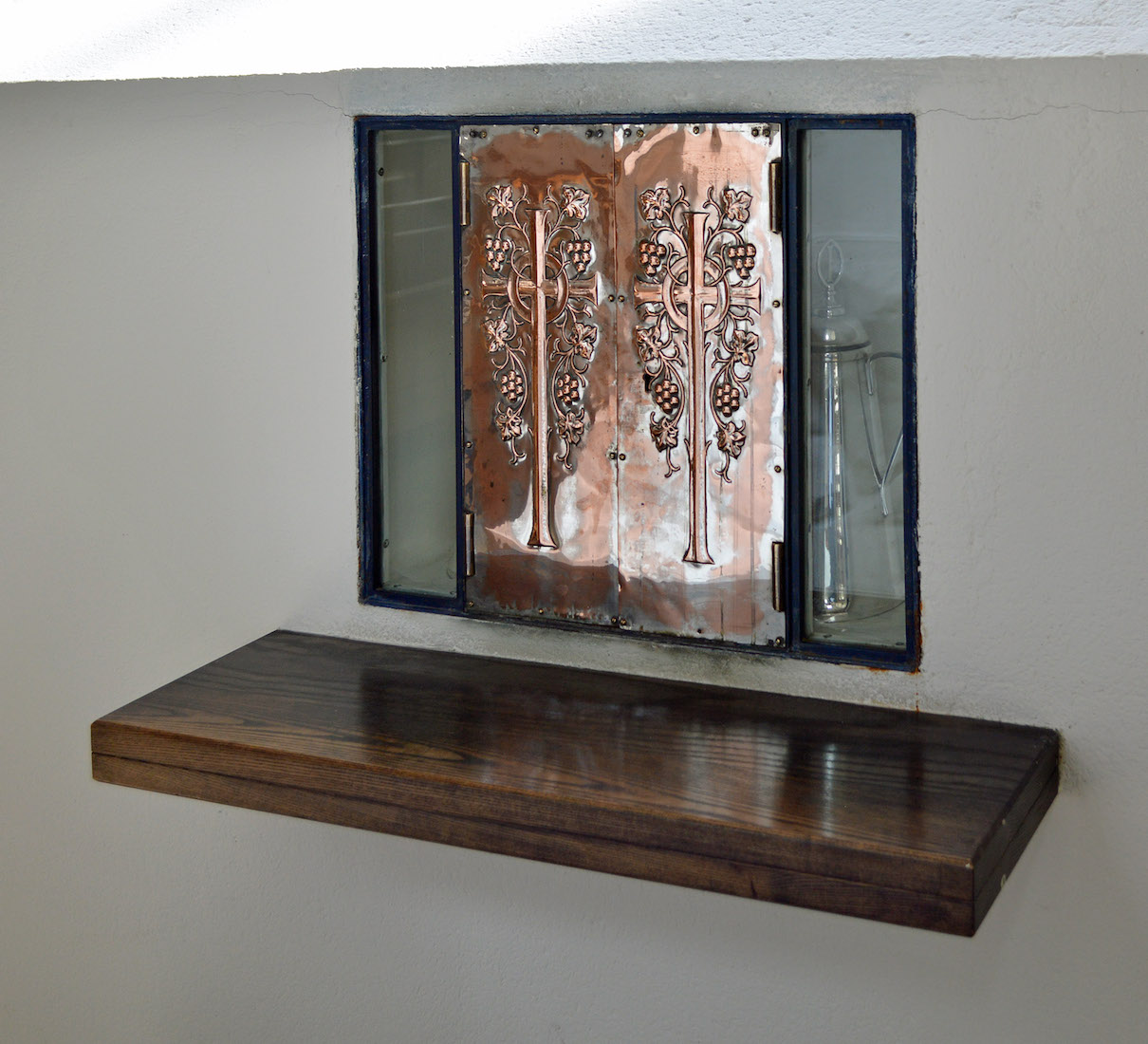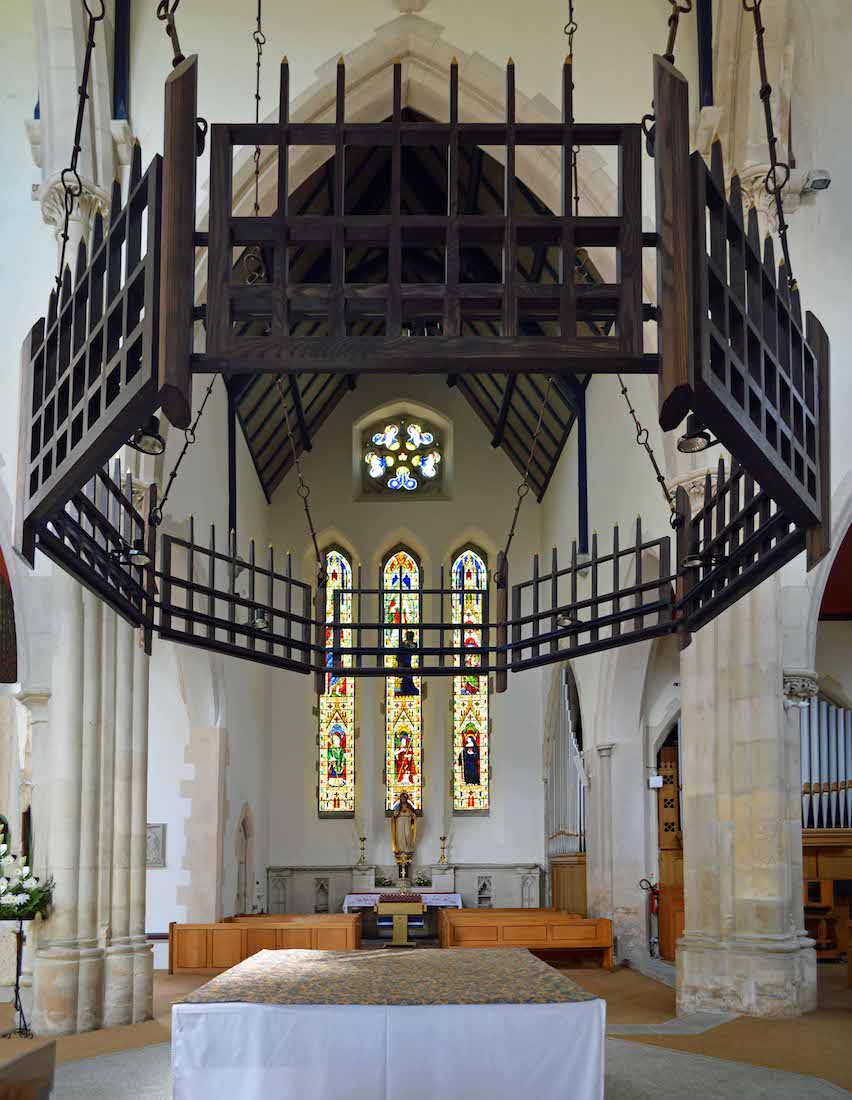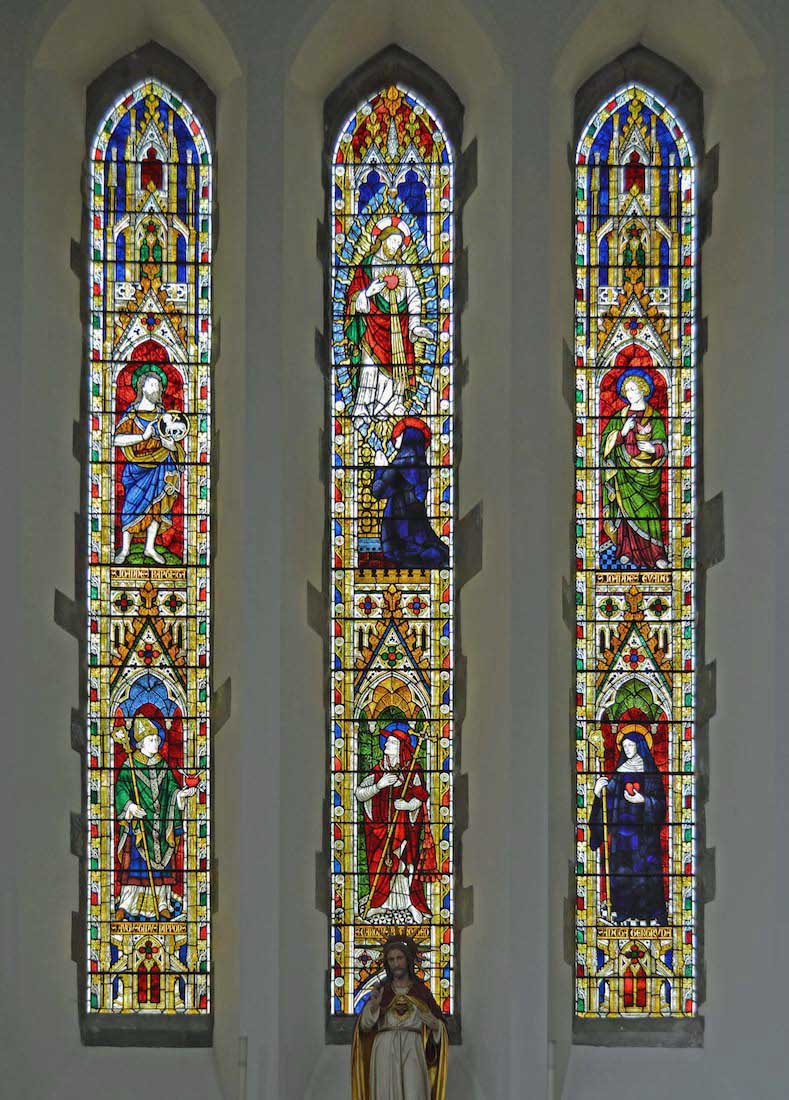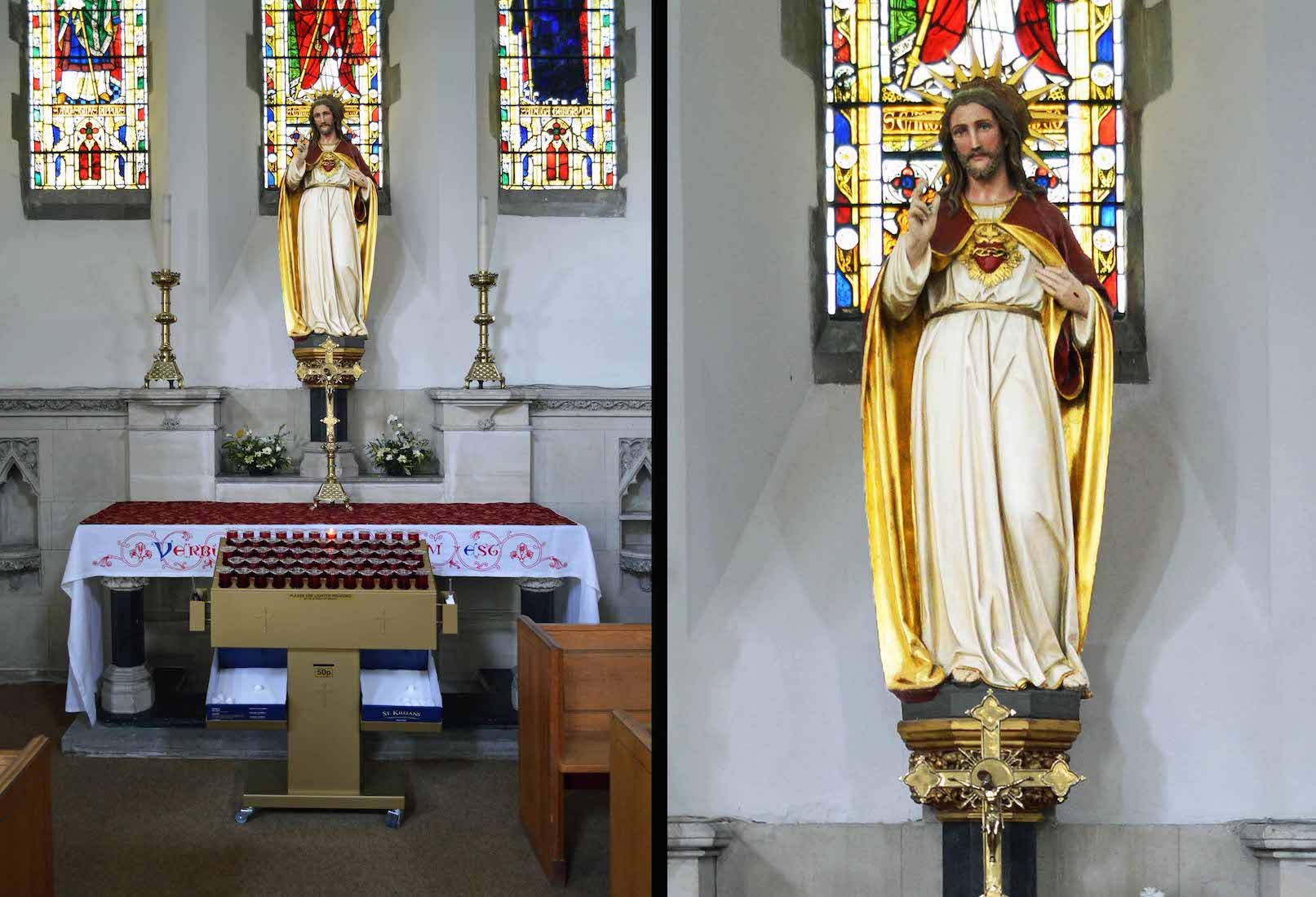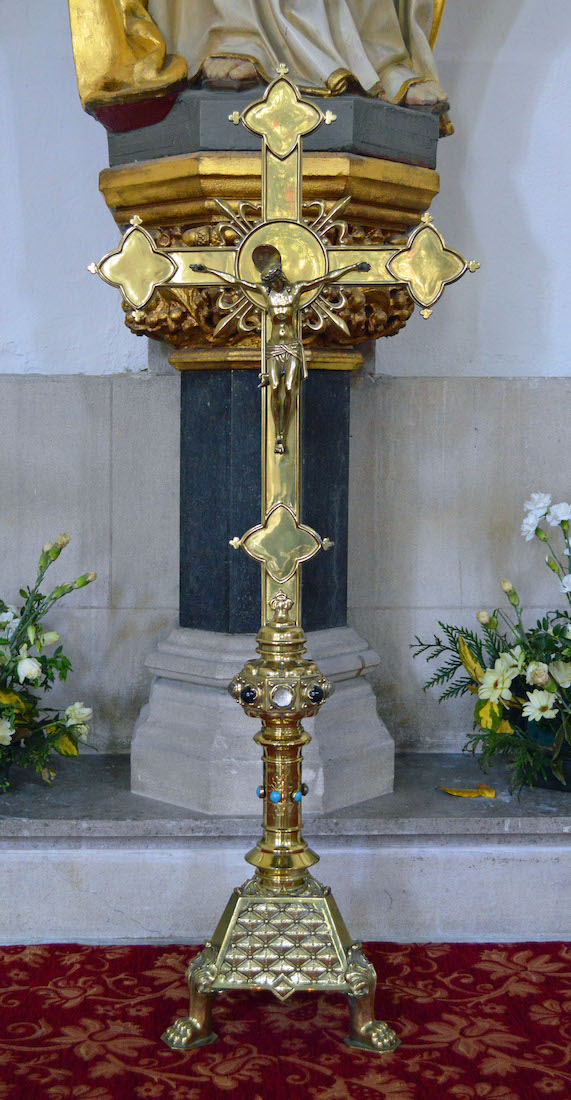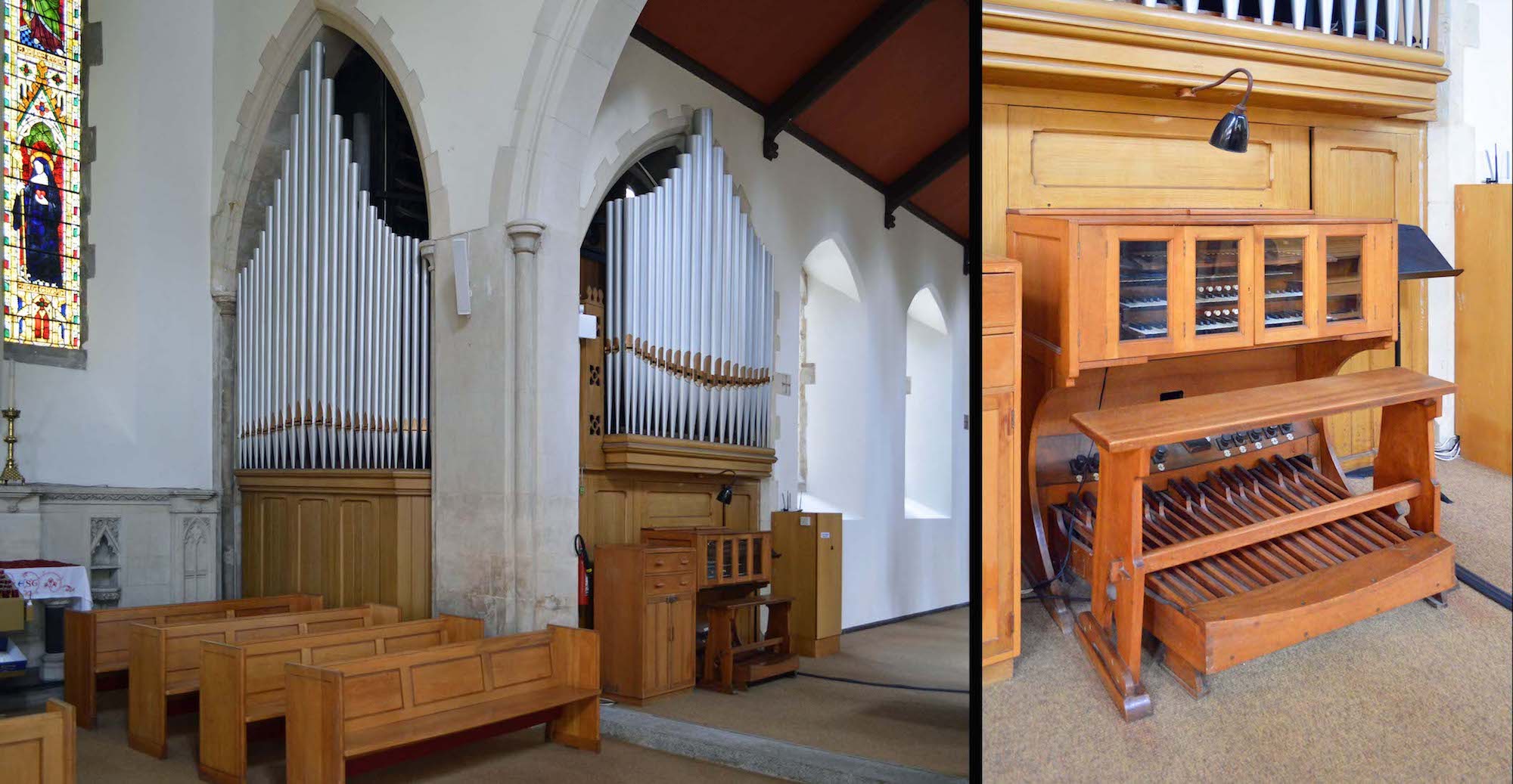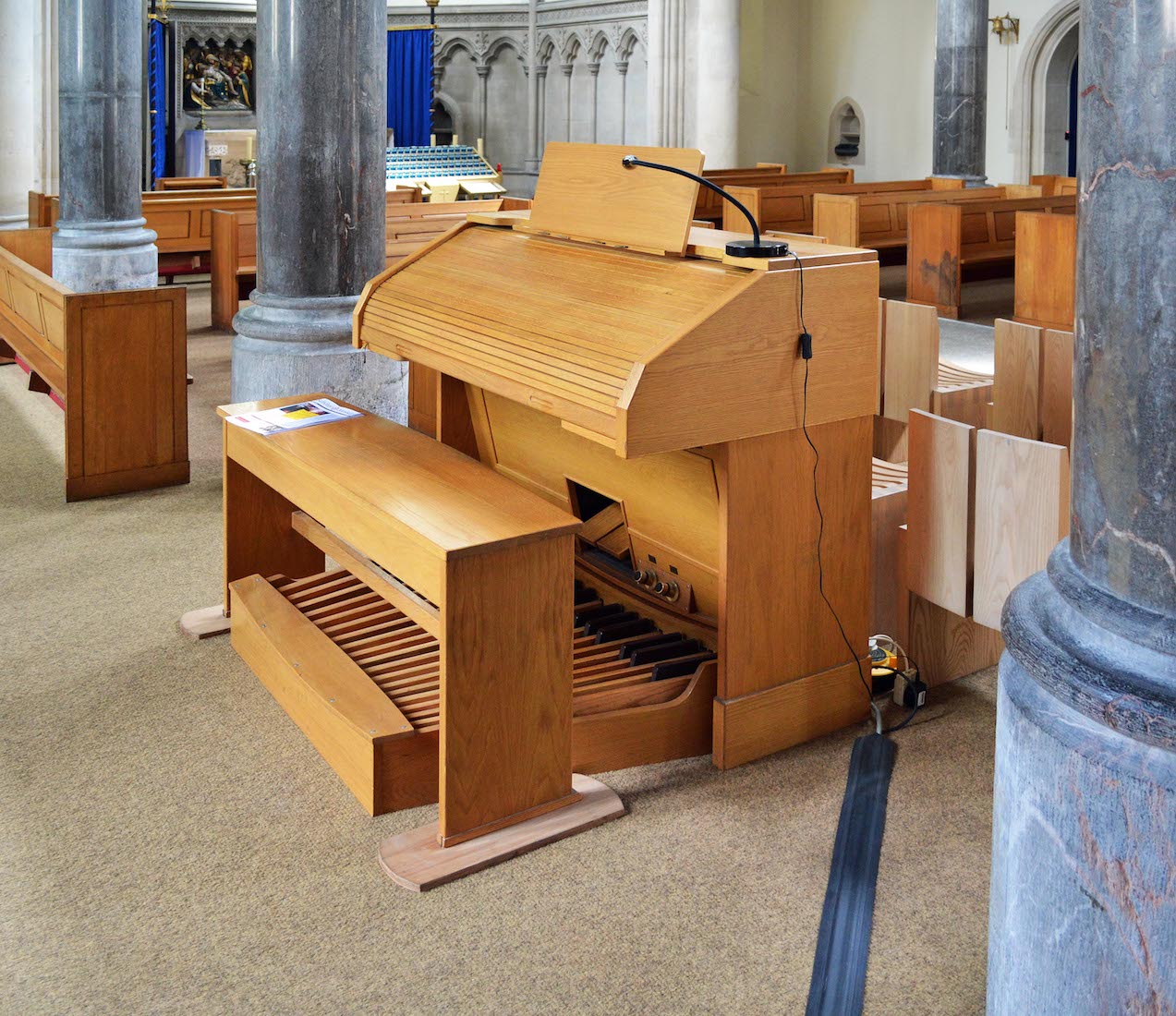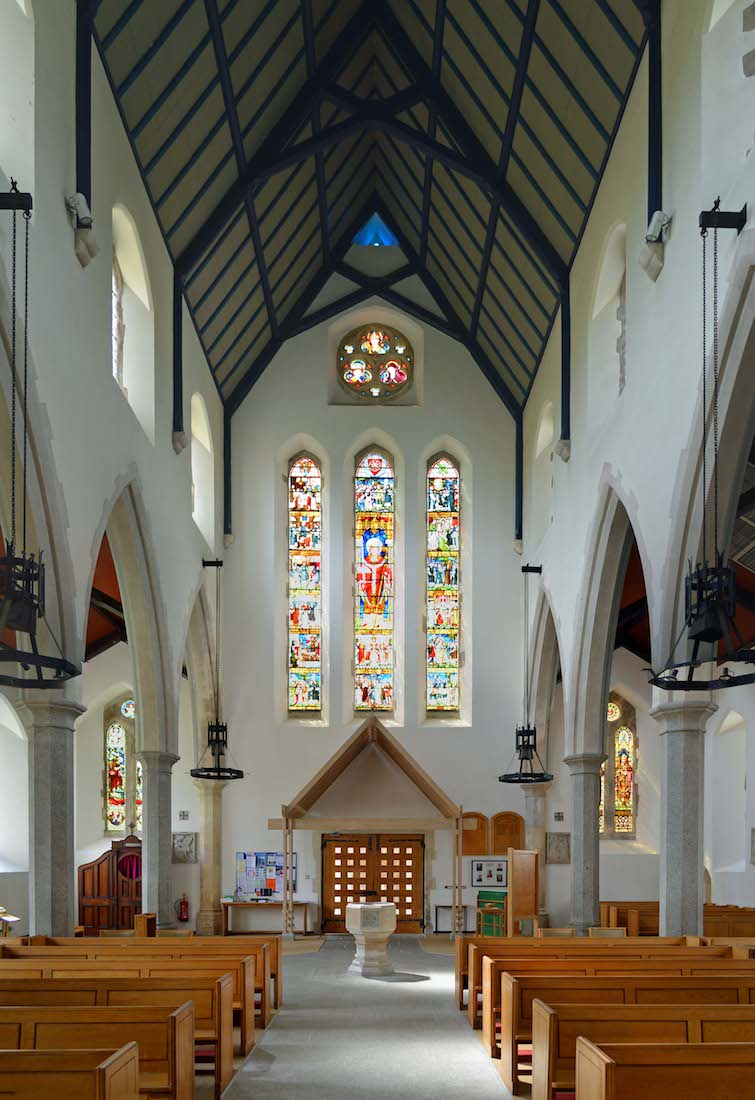
If we walk down the central nave aisle a little way and turn around, we can appreciate the West wall of the nave. The angled arch above the West doors continues the theme of the exterior walkway. Above us, the nave roof is picked out in simple black lines with a cute little blue triangle at the end. Then there are the windows: three lancets and a rose in the centre, and a smaller window on either side. INDEX
22. WEST ROSE WINDOW
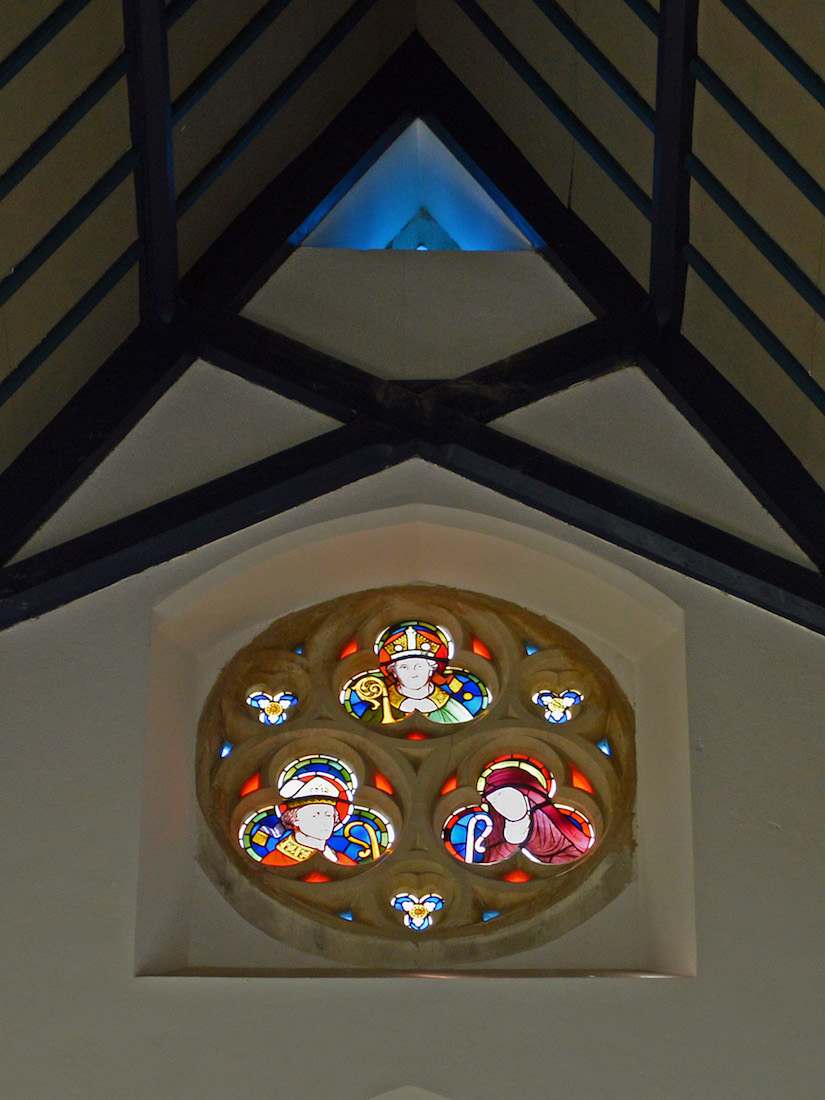
The detail of this window is poor at this distance, and I have trouble interpreting the window as well. Three trefoil figures: a king (St Boniface?), a young prince and a nun – all involved in pastoral care as indicated by the staffs.
23. WEST WINDOW
The West window contains a number of small subtitled scenes from the life of St Winifred Boniface. Boniface is celebrated (and criticized) as a missionary; he is regarded as a unifier of Europe, and he is seen (mainly by Catholics) as a Germanic national figure. In 2019 Devon County Council with the support of the Anglican and Catholic churches in Exeter and Plymouth, officially recognised St Boniface as the Patron Saint of Devon.
24. NAVE SIDE WEST WINDOWS
Pictured here are the two side windows in the West wall. The window at left shows Jesus being baptised by John the Baptist (‘Behold the Lamb of God.’) The window at right shows two saints: St Francis of Assisi, and St Francis de Sales. Francis de Sales was a Bishop of Geneva and is honored as a saint in the Catholic Church. He became noted for his deep faith and his gentle approach to the religious divisions in his land resulting from the Protestant Reformation.
25. SOUTHWEST NAVE AND ST BONIFACE
There are several other items of interest at this West end of the Cathedral. In the Southwest corner there is a confessional, and the statue of a saint – presumably Saint Boniface.
26. NORTHWEST NAVE
On the wall in the Northwest corner are two boards with lists of names. One is a list of the Bishops of the Diocese of Plymouth. The first Bishop was George Errington who served 1851 – 1855. The second board lists the Administrators and later, Deans, of the Cathedral.
27. ACROSS TO TOWER ROOM
If we stand by the font and look due North, we look into the room at the base of the tower. We have already noticed an external entry door into this space, but that appears to have fallen into disuse, as this room appears now to be a non-public utility area. The small door to the left gives access up the tower.
28. ACROSS TO SOUTH WALL
Looking the other way, due South, from the font we see a well known sculpture.
29. PIETÀ
This is a copy of the famous Pietà sculpture. The Pietà (‘The Pity’; 1498–1499) is a work of Renaissance sculpture by Michelangelo Buonarroti, housed in St. Peter’s Basilica, Vatican City. It is the first of a number of works of the same theme by the artist. It is the only piece Michelangelo ever signed. This famous work of art depicts the body of Jesus on the lap of his mother Mary after the Crucifixion.
30. WALL CUPBOARD
In the wall directly behind the Pietà is a cupboard with a shelf below. The cupboard appears to hold a couple of jugs, so may be for use with the nearby baptismal font.
31. STATIONS OF THE CROSS
Some of the 14 stations of the cross are pictured here. The stations show various stages in the journey of Jesus to the cross, and are used as an aid to meditation for Christians, particularly at Easter time. They are: 1. Jesus is condemned to death; • 2. Jesus carries His cross; • 3. Jesus falls for the first time; • 4. Jesus meets His mother, Mary; • 5. Simon of Cyrene helps Jesus carry the cross; • 6. Veronica wipes the face of Jesus; • 7. Jesus falls for the second time; • 8. Jesus meets the women of Jerusalem; • 9. Jesus falls for the third time; • 10. Jesus is stripped of His clothes; • 11. Jesus is nailed to the cross; • 12. Jesus dies on the cross; • 13. Jesus is taken down from the cross; • 14. Jesus is placed in the tomb. Occasionally a 15th Resurrection station is added.
32. NAVE ALTAR AND CORONA
At the front of the nave is a simple nave altar with a substantial corona hanging above. The corona is a ‘crown’, and the allusion here is to the kingship of Christ. The nave altar is a main focus in Cathedral services, as it is from here that the elements of the Eucharist are distributed. In fact, this view is from the side, with the North transept lying beyond the altar.
33. NORTH TRANSEPT WINDOW
There are six people featured in this window. In the left pane, top, John the Baptist and below St Augustine of Hippo. In the top centre pane, Jesus reveals himself as the Sacred Heart to St Margaret Mary Alacoque. Below is St Carolus – Charles Borromeo, who was the Latin archbishop of Milan from 1564 to 1584 and a cardinal of the Catholic Church. In the right pane, at top is St John the Evangelist, and below, St Gertrude. Gertrude the Great (1256 - c. 1302) was a German Benedictine nun, mystic, and theologian.
34. SACRED HEART
The North transept has been made into a Chapel of the Sacred Heart. The devotion to the Sacred Heart is one of the most widely practiced and well-known Catholic devotions. It takes the heart of the resurrected Body of Christ as the representation of God’s love in Jesus Christ.
35. ALTAR CROSS
On the North transept altar is a solid cross with Christ crucified. It is a reminder of the Gospel truth that Christ died for our sins.
36. CATHEDRAL ORGAN
The Cathedral organ stands on the Eastern side of the transept. We already noted this when walking around outside. The organ console appears to have three manuals. It stands round the corner in the North ambulatory.
37. NORTH AMBULATORY
The North ambulatory follows up alongside the choir stalls, separated by columns from the chancel. There are three windows along the left wall. The ambulatory leads to a chapel at the end. Another organ can be seen at right – presumably for choir use.
38. ORGAN CONSOLE
Many cathedrals have a large organ for congregational use, and a smaller organ for use with the choir, or small meetings.
39. NORTH AMBULATORY AND CHAPEL WINDOWS
The Westernmost two ambulatory windows and the window in the North wall behind the end screen have a simple repeated pattern of floral circlets. The remaining ambulatory window shows St Brigid of Ireland, and Brother Oliver Plunkett. St Brigid of Ireland, also known as Brigid of Kildare, is one of Ireland’s patron saints, along with Patrick and Columba. Irish hagiography makes her an early Irish Christian nun, abbess, and foundress of several monasteries of nuns, including that of Kildare in Ireland, who was famous and revered. Oliver Plunkett (1625 – 1681) was the Catholic Archbishop of Armagh and Primate of All Ireland who was the last victim of the Popish Plot. He was beatified in 1920 and canonised in 1975, thus becoming the first new Irish saint for almost seven hundred years.
40. NORTHEAST CHAPEL
At the end of the ambulatory is a small space behind a golden metal screen.


